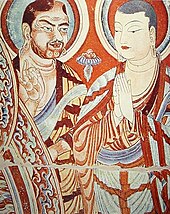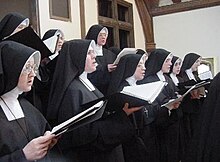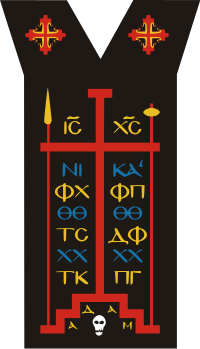
A nun is a woman who vows to dedicate her life to religious service and contemplation, typically living under vows of poverty, chastity, and obedience in the enclosure of a monastery or convent. The term is often used interchangeably with religious sisters who do take simple vows but live an active vocation of prayer and charitable work.

A mantle is an ecclesiastical garment in the form of a very full cape that extends to the floor, joined at the neck, that is worn over the outer garments. Especially in the case of Elijah, it was likely a tallit, a Hebrew garment that housed the fringes still seen today which are also translated at “the hem of His garment” in the New Testament. It is also likely that further ecclesiastical garments were based originally on this one.

The cassock or soutane is a Christian clerical clothing coat used by the clergy and male religious of the Oriental Orthodox Churches, Eastern Orthodox Church and the Catholic Church, in addition to some clergy in certain Protestant denominations such as Anglicans and Lutherans. "Ankle-length garment" is the literal meaning of the corresponding Latin term, vestis talaris. It is related to the habits traditionally worn by nuns, monks, and friars.
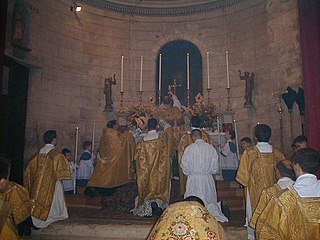
Vestments are liturgical garments and articles associated primarily with the Christian religion, especially by Eastern Churches, Catholics, Lutherans, and Anglicans. Many other groups also make use of liturgical garments; among the Reformed (Calvinist) Churches this was a point of controversy in the Protestant Reformation and sometimes since, in particular during the ritualist controversies in the Church of England in the 19th century.

A monk is a man who is a member of a religious order and lives in a monastery. A monk usually lives his life in prayer and contemplation. The concept is ancient and can be seen in many religions and in philosophy.
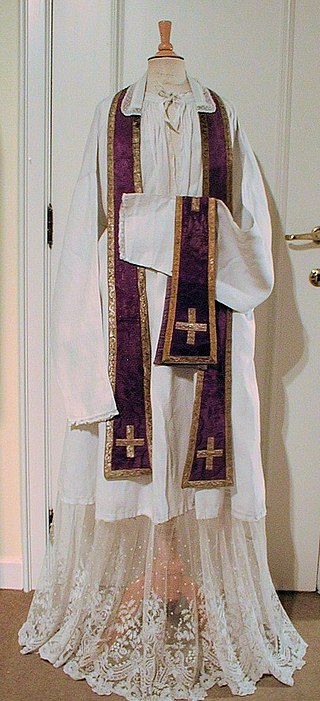
The alb is one of the liturgical vestments of Western Christianity. It is an ample white garment coming down to the ankles and is usually girdled with a cincture. It resembles the long, white linen tunic used by ancient Romans.

A scapular is a Western Christian garment suspended from the shoulders. There are two types of scapulars, the monastic and devotional scapular; both forms may simply be referred to as "scapular". As an object of popular piety, a scapular serves to remind wearers of their commitment to live a Christian life.
A novice is a person who has entered a religious order and is under probation, before taking vows. A novice can also refer to a person who is entering a profession with no prior experience.

A belt without a buckle, especially if a cord or rope, is called a girdle in various contexts, especially historical ones, where girdles were a very common part of everyday clothing from antiquity until perhaps the 15th century, especially for women. Most girdles were practical pieces of costume to hold other pieces in place, but some were loose and essentially for decoration. Among the elite these might include precious metals and jewels.
Investiture is a formal installation or ceremony that a person undergoes, often related to membership in Christian religious institutes as well as Christian knighthoods or damehoods, in addition to government offices.
A cowl is an item of clothing consisting of a long, hooded garment with wide sleeves, often worn by monks. It was developed during the Early Middle Ages. The term may have originally referred to the hooded portion of a cloak, though contemporary usage refers to an entire closed garment. A cowl is traditionally bestowed upon the monk at the time of making solemn, or lifetime, profession. Today, it is worn primarily by most Catholic and Anglican monks when participating in liturgical services. Similar garments are
Clerical clothing is non-liturgical clothing worn exclusively by clergy. It is distinct from vestments in that it is not reserved specifically for use in the liturgy. Practices vary: clerical clothing is sometimes worn under vestments, and sometimes as the everyday clothing or street wear of a priest, minister, or other clergy member. In some cases, it can be similar or identical to the habit of a monk or nun.
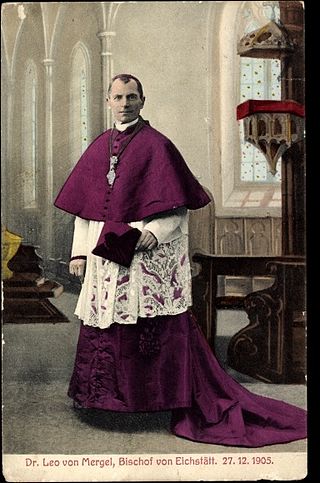
Choir dress is the traditional vesture of the clerics, seminarians and religious of Christian churches worn for public prayer and the administration of the sacraments except when celebrating or concelebrating the Eucharist. It differs from the vestments worn by the celebrants of the Eucharist, being normally made of fabrics such as wool, cotton or silk, as opposed to the fine brocades used in vestments. It may also be worn by lay assistants such as acolytes and choirs. It was abandoned by most of the Protestant churches that developed from the sixteenth-century Reformation.

Upāsaka (masculine) or Upāsikā (feminine) are from the Sanskrit and Pāli words for "attendant". This is the title of followers of Buddhism who are not monks, nuns, or novice monastics in a Buddhist order, and who undertake certain vows. In modern times they have a connotation of dedicated piety that is best suggested by terms such as "lay devotee" or "devout lay follower".
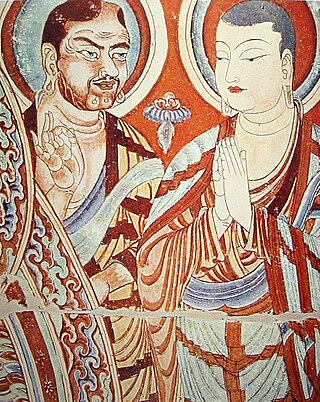
Kāṣāya are the robes of fully ordained Buddhist monks and nuns, named after a brown or saffron dye. In Sanskrit and Pali, these robes are also given the more general term cīvara, which references the robes without regard to color.
The degrees of Eastern Orthodox and Eastern Catholic monasticism are the stages an Eastern Orthodox monk or nun passes through in their religious vocation.

Twelfth century European fashion was simple in cut and differed only in details from the clothing of the preceding centuries, starting to become tighter and more similar for men and women as the century went on, which would continue in the 13th century. Men wore knee-length tunics for most activities, and men of the upper classes wore long tunics, with hose and mantle or cloaks. Women wore long tunics or gowns. A close fit to the body, full skirts, and long flaring sleeves were characteristic of upper-class fashion for both men and women.

The koukoulion is a traditional headdress worn by monks and certain patriarchs in Eastern Christianity.
Religious clothing is clothing which is worn in accordance with religious practice, tradition or significance to a faith group. It includes clerical clothing such as cassocks, and religious habit, robes, and other vestments. Accessories include hats, wedding rings, crucifixes, etc.

Zhiduo, also known as zhishen when it is decorated with outside pendulums, and haiqing, refers to two types of traditional changyi or paofu which were worn as outer robes by men in the broad sense; i.e. the casual zhiduo in Hanfu and the priests’ zhiduo, in the broad sense. As a specific term, the zhiduo refers to the former. The zhiduo was also called daopao by Wang Zhishen in the Ming dynasty although the daopao refers to another kind of paofu. Nowadays, the haiqing is sometimes referred as daopao. In present days Taiwan, the haiqing is also worn by the Zhenyi Taoist priests. The term "haiqing" can also be a specific term which refers to the long black or yellow robe worn by Buddhist monks.

